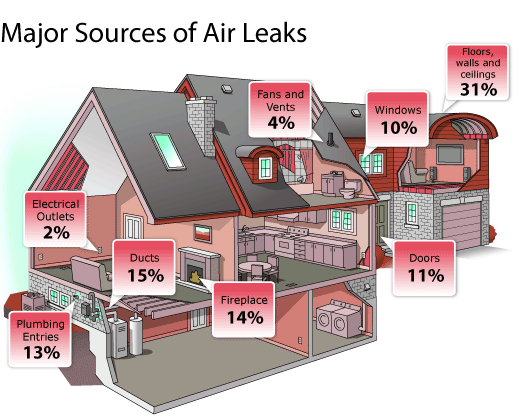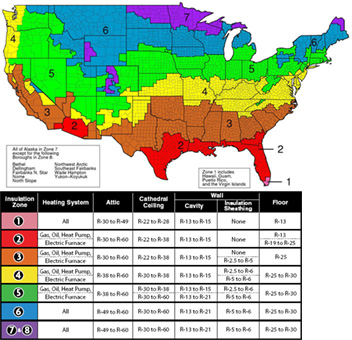
Michigan's Air Sealing and Superinsulation Specialist Benefits of Air Sealing and Duct Sealing
To get the biggest savings, add insulation in the attic and basement. The recommended insulation levels for most attics are R-49 to R-60(about 15-18 inches, depending on the type of insulation). In the coldest climates, insulating up to R-60 is recommended.
How They Work If you want to live in a thermally efficient and air tight home, it's not enough just to insulate. You must choose the right insulation and air sealing system for the application, and be sure it's properly installed.
If you want to live in a thermally efficient and air tight home, it's not enough just to insulate. You must choose the right insulation and air sealing system for the application, and be sure it's properly installed.
Our Building Science experts understand the principles of heat, air and moisture flow, and how the building envelope interacts with a building's mechanical systems as well as its occupants.
N.A.S.A. applied one-inch of spray-on foam insulation on the Space Shuttle's External Tank that serves to insulate the tank. The closed-cell foam used on the tank was developed to keep the Shuttle's liquid hydrogen fuel at minus 423 degrees Fahrenheit and the liquid oxygen tank at near minus 297 degrees Fahrenheit even as the tank sits under the hot Florida sun while preventing a buildup of ice on the outside of the tank.
The closed-cell foam used on the tank was developed to keep the Shuttle's liquid hydrogen fuel at minus 423 degrees Fahrenheit and the liquid oxygen tank at near minus 297 degrees Fahrenheit even as the tank sits under the hot Florida sun while preventing a buildup of ice on the outside of the tank.
Did you know that an improperly insulated and sealed home delivers 4500 lbs. of excess greenhouse gases into the air each year? It can also waste 20 percent or more of the energy used to heat and cool the home.
Properly insulating and sealing your homes with Spray Foam is a greener alternative.
We can help you in specifying the right insulation system for our local climate. Contact our Building Science experts with your inquiries at (855) 830-8900 or use our convenient Contact Form Insulation Experts Visit our Insulation website for more in depth information Without proper air sealing, a building can lose a great deal of its efficiency through air leakage. It's one of the primary causes of hot and cold spots that can cause discomfort for owners. But as with any building product, insulation is only as effective as its installation and where it's applied. Spray foam is only installed by qualified contractors. That's why builders are choosing Spray foam to insulate their homes.
Stop by and learn all about the Science of Building Performance at ComfortToLife.com
- Improved Comfort - Drafts felt during the winter are often the result of unsealed cracks and holes. Sealing homes tightly typically results in fewer drafts and less noise.
- Lower Utility Bills - Air leakage and improperly installed insulation can waste 20-40 percent or more of the energy used to heat or cool a home. With effective air sealing and insulation, heating and cooling systems will work more efficiently, ultimately costing less to operate.
- Improved Indoor Air Quality - A tighter home envelope reduces the amount of humidity, dust, pollen, and pests that can enter the home helping improve indoor air quality and improving the impact your home has on your personal health.
- Increased Durability - When warm air leaks through a home's floors, walls, and attic, it can come in contact with cooler surfaces where condensation can occur. Moisture that occurs in these construction assemblies encourages mold growth, ruins insulation, and even compromises the structural elements of the home. Reducing air leakage helps minimize moisture problems and increases the home's durability.
To get the biggest savings, add insulation in the attic and basement. The recommended insulation levels for most attics are R-49 to R-60(about 15-18 inches, depending on the type of insulation). In the coldest climates, insulating up to R-60 is recommended.
- Attic - Adding insulation to an unheated attic is easier than insulating existing walls and is likely to have a greater impact on comfort and energy use. If there is no floor in the attic, simply add more insulation between the ceiling beams, with loose fill cellulose.
- Basement - Materials that could be damaged by moisture, such as fiberglass batts and cellulose, should never be used to insulate basements walls. Interior vapor barriers should not be used on concrete basement walls as it creates unnecessary moisture.
Interior basement insulation should start with rigid foam installed against the basement walls. Dramatic heat loss reduction can be achieved by insulating the rim joist and foundation walls. The rim joist is normally the largest area of air infiltration in any building. Eight inches of poured concrete (typical foundation) represents a cumulative R value of one, the same as a single pane of glass!
If you are considering finishing your basement and using it as a living space, seek the advice of an experienced professional. - If you have a crawl space, it should be sealed, not ventilated. To do this, use 6-mm thick polyethylene sheeting as a moisture barrier to cover the ground and seal tightly to walls and columns. Then use rigid foam or spray foam to insulate the foundation walls.
- Lowers heating and cooling bills
- Improves the comfort of your home
- Warmer floors over basement/crawlspace
- Reduces your carbon footprint
- Increases the value of your home
How They Work
- Heat travels from a warm area to a cool area by a combination of conduction, convection, and radiation.
- Heat flows by conduction from a hotter location within a material or assembly to a colder location.
- Heat transfer by convection occurs when a liquid or gas is heated by a surface, becomes less dense, and rises (natural convection), or when a moving stream of air absorbs heat from a warmer surface (forced convection).
- Radiant heat travels in a straight line away from any surface and heats anything solid that absorbs the incident energy. Radiant heat transfer occurs because warmer surfaces emit more radiation than cooler surfaces.
- Reflects up to 97% of the incoming solar heat gain rather than absorbing it
- Reduces summer heat gain and winter heat loss
- Descreases the ambient air temperature of your attic
- Allows your heating and air system to function more efficiently, which lowers your heating and air costs

Our Building Science experts understand the principles of heat, air and moisture flow, and how the building envelope interacts with a building's mechanical systems as well as its occupants.
N.A.S.A. applied one-inch of spray-on foam insulation on the Space Shuttle's External Tank that serves to insulate the tank.

Did you know that an improperly insulated and sealed home delivers 4500 lbs. of excess greenhouse gases into the air each year? It can also waste 20 percent or more of the energy used to heat and cool the home.
Properly insulating and sealing your homes with Spray Foam is a greener alternative.
The History Channel - Modern Marvels did a great segment about the benefits of Spray Foam Insulation Technology.  Brought to you by The History Channel
Brought to you by The History Channel
Modern Marvels (7:07)
Benefits of Spray Foam Insulation  Brought to you by The History Channel
Brought to you by The History Channel Modern Marvels (7:07)
- Dramatically reduces moisture infiltration through air leakage in roof assemblies
- Provides a continuous barrier or air seal
- Expandable Spray Foam can easily envelope and seal any surface
- Resists heat movement in all directions
- Minimizes dew point problems and condensation
- Adds structural integrity
- Seals cracks from unwanted gas and odors
We can help you in specifying the right insulation system for our local climate. Contact our Building Science experts with your inquiries at (855) 830-8900 or use our convenient Contact Form Insulation Experts Visit our Insulation website for more in depth information Without proper air sealing, a building can lose a great deal of its efficiency through air leakage. It's one of the primary causes of hot and cold spots that can cause discomfort for owners. But as with any building product, insulation is only as effective as its installation and where it's applied. Spray foam is only installed by qualified contractors. That's why builders are choosing Spray foam to insulate their homes.
Stop by and learn all about the Science of Building Performance at ComfortToLife.com



